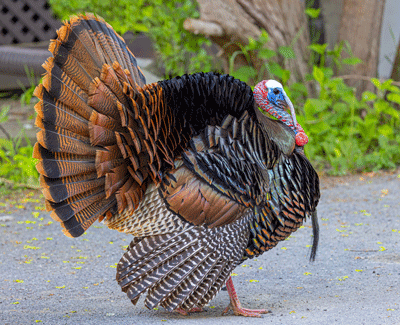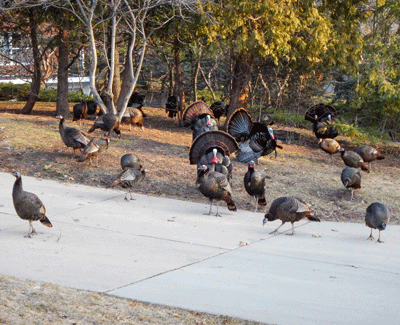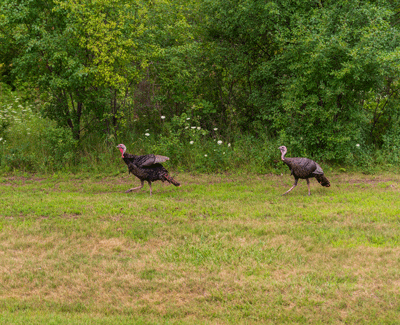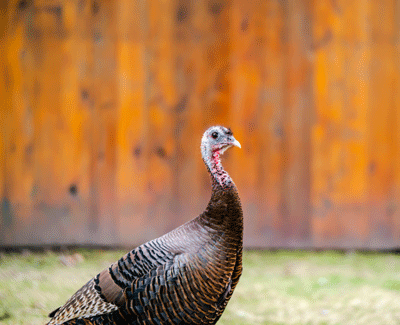




In North America, there are five different species of wild turkeys. Merriam’s wild turkeys are the predominant turkey species in Montana. Montana has spring and fall turkey hunting seasons each year. Wild turkeys are omnivores and forage for a variety of foods, such as insects, seeds, nuts, frogs and snakes. Some of the larger birds in North America, males, or “toms,” can weigh 18 to 30 pounds while females, or “hens,” can weigh 9 to 12 pounds. Turkeys are active during the day and roost in trees at night to avoid predators. They nest on the ground and the young turkeys (poults) are able to leave the nest shortly after hatching. They immediately begin foraging for insects but stay in a brood with the hen until their flight feathers have developed.
Keep wildlife wild! Do not feed. Feeding wild turkeys—either intentionally or unintentionally—may change their foraging habits, cause them to be bold or aggressive and congregate. Typically, turkeys move throughout the day, foraging for a variety of natural foods. Artificial feeding can motivate turkeys to stay in a single location, which may increase flock size and cause an increase in disease transmission. Feeding of wild turkeys can be unlawful if the feeding harms local populations, including through increased disease transmission, or creates a public nuisance. These situations are handled on a case-by-case basis and can result in fines up to $1,000.
If you have bird feeders in your yard, ensure the area below feeders remains clean and the feed is inaccessible to species such as turkeys and deer. Unsecured garbage can also become a food source for turkeys.
Wild turkeys can become a public safety concern due to their:
Powerful wings
Large size (males can weigh over 20 pounds and stand 3 1/2 feet tall)
Sharp spurs on males’ legs
Tendency to occur in large flocks of 6 to 12 birds
Once aggressive behavior is established, it’s difficult to change.
Another problem with feeding wild turkeys in residential areas is they’ll remain in a neighborhood or community, which can eventually lead to pecking and scratching cars, tearing up flower beds and depositing turkey droppings on driveways, sidewalks, yards and porches. Turkeys have been known to begin roosting on roofs and pool screens, which can result in considerable property damage.
Non-lethal hazing is effective in deterring turkeys away from your property. Though large birds, turkeys can be scared easily.
Common turkey hazing techniques include:
Tethered barking dogs
Loud noises: yell, airhorn, whistle, etc.
Get physically big: wave arms, open an umbrella, etc.
Spray water from hose or squirt gun
Install motion-activated sprinklers
Remember, these hazing tactics are intended to scare turkeys, not physically harm or kill them. Hazing roosted turkeys helps motivate them to leave the area. A roost is any elevated surface a turkey can rest upon for security at night. Roost hazing can be done with a hose preferably before dark.
Mating season for turkeys is between February and May. Males often become more aggressive and territorial during this time as they seek out a female and can attack their own reflections in objects such as cars and glass doors. Cover these reflective surfaces for the mating season or use hazing tactics described above to deter turkeys from your property and prevent damage.
Montana Fish, Wildlife & Parks does not relocate wild turkeys. Relocating birds can increase disease transmission and spread among bird species. Some urban turkey populations may include domestic turkey genetics, and risk of spreading domestic turkey genes to wild populations is also a concern. Moving nuisance turkeys from one location to another does not solve the problem of nuisance turkeys, it merely relocates it. Do not feed wildlife, including wild turkeys, and haze them when appropriate to reduce the number of nuisance turkeys.
